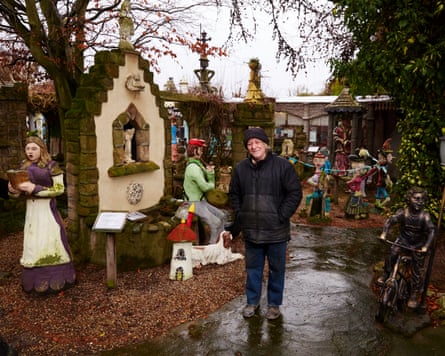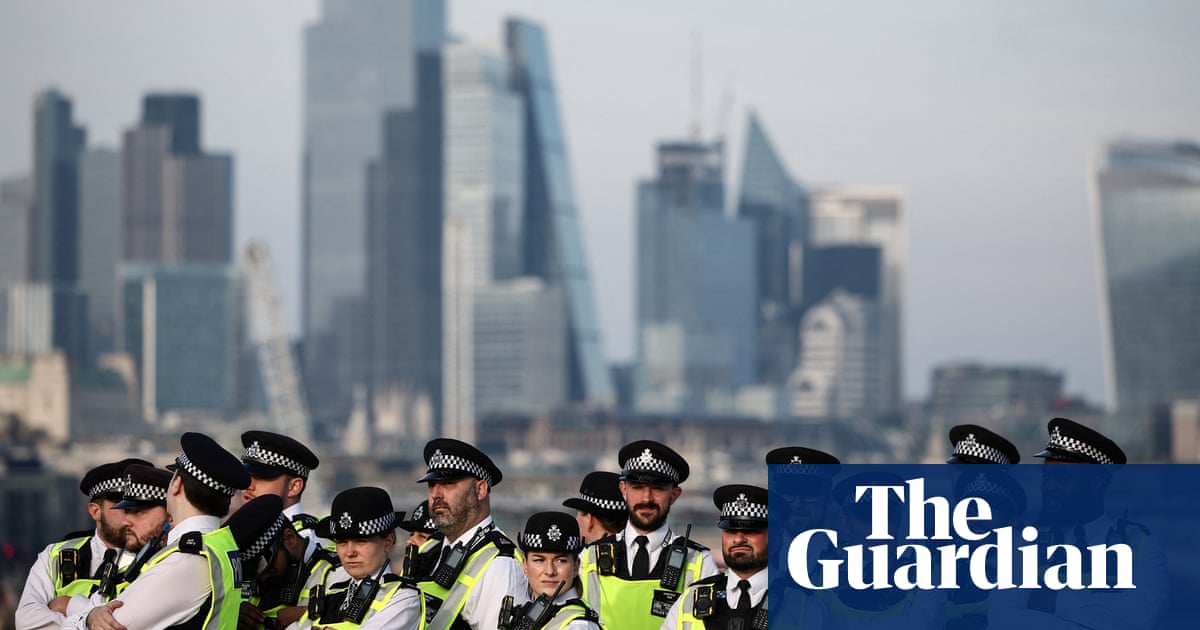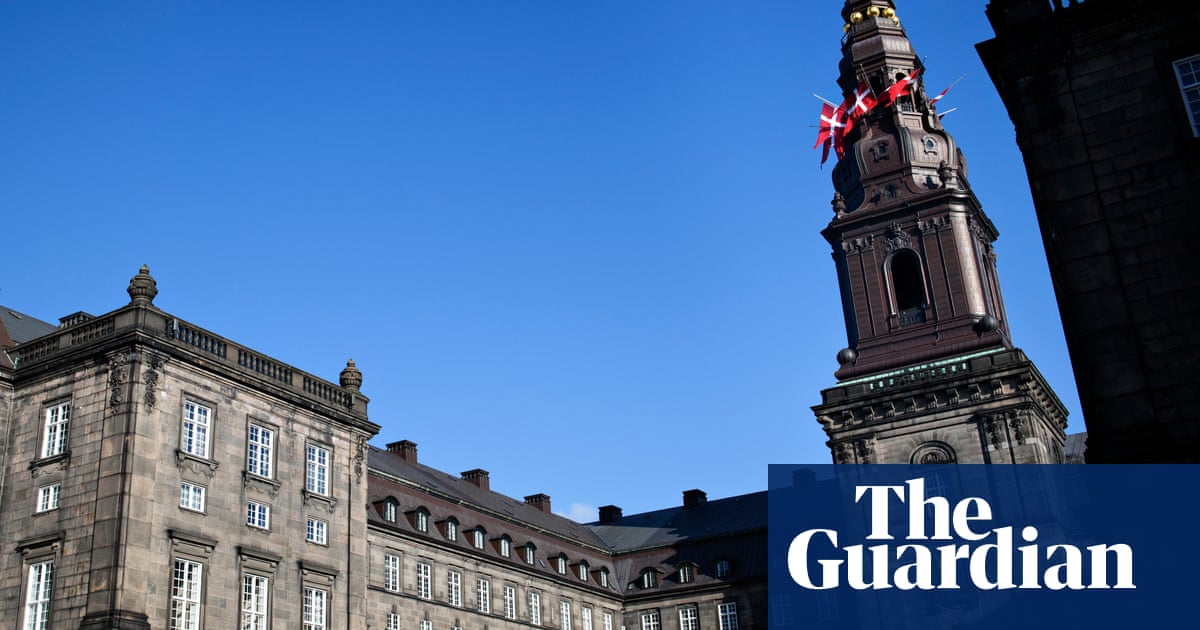Kevin Duffy’s fairytale was born on a dumping ground. Nobody else could see it, but to him, the overgrown remains of a 1920s bowling green promised untold potential. It was there he spent the last decades of his life creating castles, characters, and crude Tudor facades from chicken wire, cement, and anything else he could salvage, across the land surrounding his Wigan bungalow, spilling over into the family garden centre.
Not many people have heard of Duffy – who died in September at 79 – or his work, all housed at his now-closed family business, Rectory Nurseries. But first reactions are often the same: bewilderment followed by unbound wonder and curiosity. After four decades, Duffy’s kingdom is full of nooks and pathways, chapels and dens, monsters and myths – each discovery promising another just around the corner. The Rectory features not just its own miniature pub, but a lion’s den as well as a stalactite-encrusted cave of sirens. One section hosts a small Tudor village, another a crowded antique shop where none of the items are for sale. It’s like wandering into a theme park.

Iain Jackson, a writer and architect who interviewed Duffy for an outsider art publication called Raw Vision in 2008, admits Duffy’s work couldn’t be shown in a gallery, but says, “he still did it; he still had something to say – he was the real deal”. Yet along with his legacy as a much-loved outsider artist, Duffy has left a 1,200 sq foot property full of sculptures, found objects and oddities that nobody is quite sure what to do with.
The land that the Rectory sits on is being forced into a sale, leading many locals to ask why Duffy’s work can’t be given protection. An idiosyncratic ground-floor rented flat in Birkenhead known as Ron’s Place became what was thought to be the first outsider art to get Grade II-listed status last year. But today the Rectory lies stagnant; the gates closed to the public, as vines and trees encroach the Renaissance follies like a post-apocalyptic Portmeirion.
“Eccentric” is the word Duffy’s nephew Chris uses to describe him. Duffy variously performed in a husband-and-wife musical duo, worked in a cotton mill, had an encyclopedic knowledge of gardening, and played the left-handed banjo. In the evenings when his family gathered, wearing his cowboy’s neckerchief, he would drink and play music long into the night, outpacing even his most spirited nephews.
His eldest sister, Sheila, says he had been a charismatic child, but other than an appreciation for architecture, he wasn’t an obviously creative type. Instead, Duffy grew up to be a grafter, his hands tough like old leather. In around 1978 he started leasing the ground for £1 a year and cleaning it up, eventually building his bungalow in 1991, while selling cuttings for plants and slowly building up his nursery business.
Duffy – who has sometimes been called “Wigan’s Gaudi” by visitors to the site – only started making art after Boxing Day in 1994, when his wife, Pat, died suddenly. A stone monument was erected in the garden in her memory, and decades of unrelenting creativity followed. Grief and remembrance feel enshrined in the Rectory. The all-faith chapel – which was originally built tongue-in-cheek from old lavatory bricks with an altar made of scaffolding planks – became a genuine place of reverence and, judging by the amount of touching prayer messages pinned up, was giving the 17th-century Holy Trinity church down the road a run for its money.

Duffy’s works weren’t built to stand as individual pieces – instead he used his home-cum-garden centre as an ever-changing exhibition that people, and mostly himself, could enjoy. Layer after layer of strange objects created a magnum opus in over a hundred intertwined sections: a hand-sculpted Mr Darcy; the gravestone of a 58-year-old donkey; a shrine to his late wife and only son Carl, who died aged 56 in 2023.
The creations were tied to whatever materials were freely available (or donated) at a given moment. Like the seedlings that fuelled his business, Duffy had a knack for creating something from nothing – “building a lot without buying a thing” as he put it. He once said in a video made about him: “Is it art or is it just a pile of rubbish?”
Regardless of the answer, Duffy’s wonderland may yet end up in the bin, and his work is just the latest in a long history of outsider art under threat. From paintings mistaken for trash to artworks being saved from skips and ending up in the Saatchi, the preservation of outsider art often depends on the taste and perseverance of a tenacious few.

The loss of its creator looms over the Rectory. “The fact that Kevin is no longer with us is hard enough,” says Sheila, “but having to sell all his years of work just as a commercial venture is very sad.” The family, who don’t own the land, hope that someone will buy the property and keep at least some of Kevin’s work. Ideally they’d like it all preserved, but they’re being realistic.
After all, as Chris explains, perfection and preservation was never his uncle’s goal. In fact, Duffy enjoyed the look of ivy creeping across his faux battlements, which undoubtedly inflicted structural damage over the years. His bottomless reserves of energy meant the layout of the Rectory could change on a whim of creative inspiration. A greenhouse easily became a village, a potting shed became a chapel.
Without Duffy, the Rectory is still changing, as nature begins to reclaim it. Conifers invade the boundaries and ivy multiplies, while sculptures gradually forget their painted colours. It’s a stark reminder of time’s passing, and photos from 10 years ago show a tidier, prouder environment.
To some, a bid to conserve Duffy’s visionary environment may be a folly of its own. “I don’t think we have to preserve absolutely everything,” says Jackson. “It existed for a moment. And those people that saw it had the luck and the privilege and that authenticity. There’s a risk of it becoming museum-ified.” But Chris is hopeful about his uncle’s legacy, even so. “No matter what happens to the garden in the future, our Kevin has left his own unique mark on the world and the pictures and memories will be forever.”

 1 day ago
10
1 day ago
10

















































